While working out is an important part of being healthy, getting stronger and preventing injury, that doesn’t always mean you have to go spend an hour or two at the gym.
Sometimes simply moving more and doing the opposite of what you do seated at your desk hunched over a computer screen for 9 hours a day is enough to start alleviating aches and pains. Sometimes all you need to do is a 15-minute workout at your desk.
And a Resistance Band or Thera-Band Tubing is really all you need to get in a great workout at your desk.
With Resistance Bands, you can work your entire body to improve your strength, posture, and help prevent and alleviate neck, shoulder, upper back, low back, hip and even knee pain.
When we sit all day at a desk hunched over a computer screen, our body is in flexion. This can create bad posture, tight overactive muscles and imbalances. All of which can lead to compensations and poor movement patterns which will eventually lead to injury.
Therefore we need to move more. But not simply move more while perpetuating the imbalances. We need to move more and do exercises that can help restore our body to proper alignment and improve our movement patterns.
We need to move not only more, but better.
To prevent and alleviate injuries and improve your health while staying right at your desk, try these 15 Resistance Band Moves To Do At Your Desk.
15 Resistance Band Moves To Do At Your Desk
Below are Upper Body, Lower Body and Full-Body/Core Focused Exercises to do with the Resistance Band. These moves should help open you up after sitting at your desk all day.
Try some of these moves whenever you get up from your desk!
Upper Body
These upper body moves will help you get the big muscles of your back activated and working to help you prevent neck, shoulder and upper back pain.
They will also improve your posture and help you lift more and do more pull ups during your workouts
Shoulder Flossing:
Using the Resistance Band, you can open up your chest, shoulders and improve your posture. The Shoulder Flossing Exercise is a great stretch using the band that you can do sitting right at your desk.
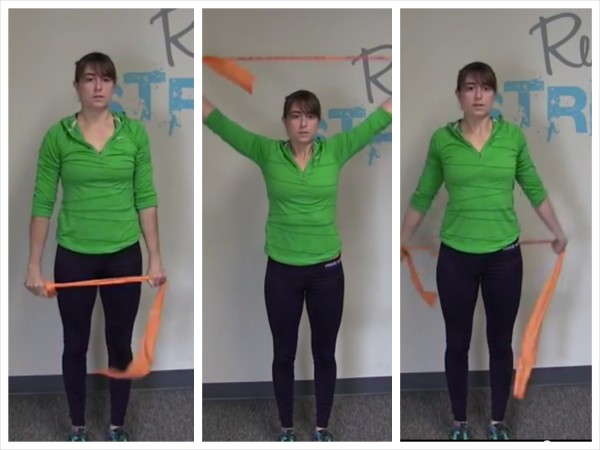
To do Shoulder Flossing, hold the band in both hands with your hands about shoulder-width apart. Stand up nice and tall with your chest pressed out.
Keeping your arms straight, lift your arms up overhead and then open them back up behind you. Reach them back toward the ground behind you then bring your hands back overhead and forward.
Because the band will stretch, it will give you a little play and allow you to open up wider if needed to get your arms in a full circle. Hold in closer on the band as you gain more mobility and don’t need the band to stretch as much to allow you to complete the circle.
Complete 10-15 slow circles, keeping a nice tall posture and your chest pressed out as you complete the circles.
Scapular Band Flyes:
Scapular Band Flyes are one of the best moves to activate your lower traps and alleviate neck and shoulder pain. They will improve your posture and they are a great activation exercise to help you improve your pull ups.
Below are 3 variations of the Scapular Band Fly you can do to work the big underactive muscles of your upper back from different angles. Make sure as you do all three movements that you feel low between your shoulder blades and even the backs of your shoulders working and not simply your upper traps taking over.

To do the straight on Scapular Band Fly (the one on the left), hold the resistance band with your hands about shoulder-width apart and press your chest out so you are standing nice and tall. Keep your neck and shoulders relaxed. Do not shrug. Raise your arms up straight in front of you at about shoulder height or right below. Keeping your arms straight, pull out on the band to open your arms out to the sides. Pinch your shoulder blades down and together as you open and bring the band in to your chest. Do not let your shoulders shrug up as you pull the band. Hold with your arms open for a second or two and feel your back working. After holding to feel your back working, bring your arms back together so your arms are about shoulder-width apart again and there is no slack in the band. Repeat the fly. Do not let the band pull you. Move slowly. If you have to bend your arms to do the fly or if your shoulders shrug up, you may want to go lighter.
To do the overhead angled Scapular Band Fly (the one in the middle), you will hold the band overhead in front of you with your hands about shoulder-width apart. Then pull your arms straight out and down as you draw your shoulder blades down and together. Your arms should stay straight the entire time as you bring the band down to your chest. Press your chest out and make sure you keep your shoulders and neck relaxed.
The third Band Fly (the one on the right) is an overhead move in which you pull the band down behind your head. Hold the band with your hands about shoulder-width apart and start with your hands up overhead. Then pull your arms straight down and out to pull the band down toward the back of your shoulders. Keep your chest pressed out and draw your shoulder blades down and back as you pull the band down. Pull it behind your head and bring your arms straight out to the side at about shoulder height. Once the band reaches your shoulders, slowly bring it back overhead.
Complete 10-15 reps of at least one of these moves if not all three.
Band Row:
Another great move to get the big muscles of your back working and stronger is the Band Row. The Band Row works your Lats, Traps and Rhomboids to improve your posture and prevent and alleviate neck and shoulder pain.
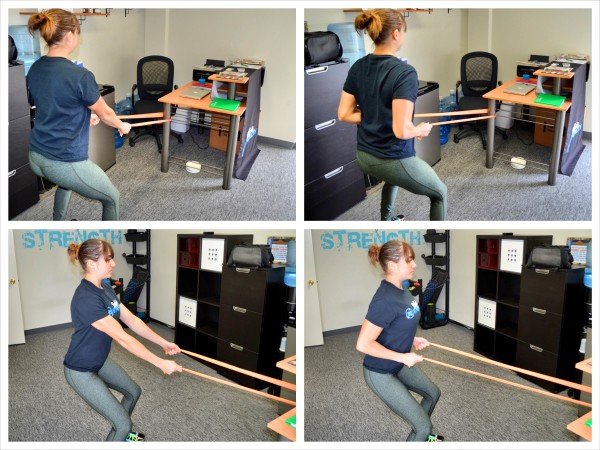
To do the Band Row, wrap the band around a leg of your desk and hold an end in each hand.
Facing the anchor point, step away from the anchor point and sink into a little squat. Sit your butt back and keep the chest up nice and tall with the arms extended out in front of you.
Then row the band back to your chest or just below. Pinch your shoulder blades down and back as you row the band back. Stay in the squat as you row back and make sure to keep your chest up nice and tall and your back flat.
Do not round forward as you row or shrug your shoulders. You want to drive your elbows down and back so that the big muscles of your back activate instead of irritating your upper traps by making them do work they can’t handle.
Row the band all the way in to your body and then straighten your arms back out. Stay in control of the band the entire time.
Sink lower in the squat to work your legs more or move back further from the anchor point to increase the tension. You can also slow down the tempo of the movement to make it harder. More time under tension can produce better results!
You can also row one arm in at a time and alternate rows to make this a unilateral move and work each side independently. This can help you correct imbalances because your stronger side can’t take over.
Complete at least 10-15 Rows.
Pull Downs:
Pull Downs are a great way to activate your lats and lower traps to improve your posture and help you do more pull ups. You may also feel them in the outside and back of your shoulders.
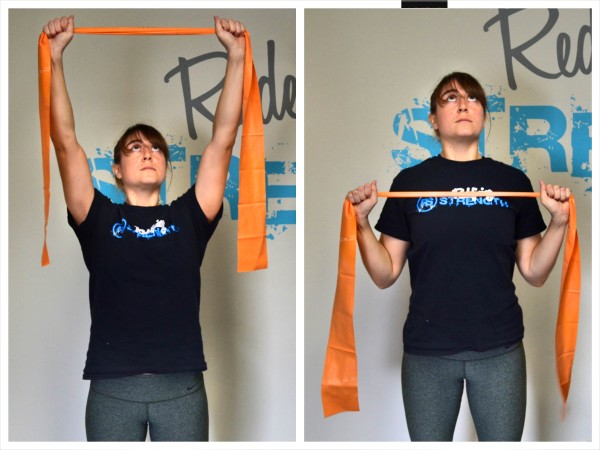
To do Pull Downs, grab the band with both hands about hip-width apart and pull your hands away from each other so there is tension on the band. Then press the band overhead, keeping the band tight between your hands. (You may need to adjust your hands in closer if the band is light.)
Press your chest out and pull the band down toward your chest, pinching your shoulder blades down and back as if you were doing a pull up to the bar. Drive your elbows down to the ground as you pull the band down keeping it tight between your hands.
You can either hold at the bottom of the pull or complete repetitions. If you do repetitions, move slowly and make sure to maintain tension on the band the entire time.
Complete at least 10-15 Pull Downs.
Straight Arm Shoulder Extension:
A great move to help prevent and alleviate rotator cuff pain and injury while also strengthening your upper back to improve your posture is the Straight Arm Shoulder Extension.
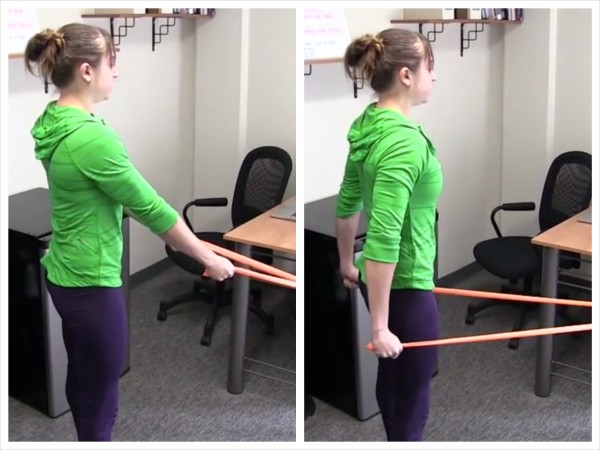
To do the Straight Arm Shoulder Extension, wrap the band around a leg of your desk and hold an end in each hand.
Facing the anchor point, step away from the anchor point so there is tension in the band. Stand up nice and tall with your feet about hip-width apart and your arms straight down by your sides.
Then, keeping your arms straight, pull back on the band. Stand up nice and tall as you pull back on the band.
This won’t be a huge range of motion. Just focus on your back pulling the band back as your arms stay straight. Pinch your shoulder blades down and back as you pull back.
Hold for a second or two then relax your arms back forward and repeat.
Do not shrug your shoulders as you pull the band back. Also make sure your triceps don’t do all the work. Focus on your back working and maintaining a nice tall posture.
Complete 10-20 reps of the Straight Arm Shoulder Extension focusing on moving slowly and holding at the end.
Lower Body
When you sit all day, your hips are in flexion, which can cause inactive glutes, weak abs and even low back and hip pain. That is why you need to focus on doing exercises that promote hip extension and work to activate your glutes.
These Resistance Band exercises will get your glutes working and will help you open up your hips after sitting all day.
Standing Kickback:
The Resistance Band is a great tool to activate your glutes. And one great standing move you can do to work your glute maximus is the Standing Kickback.
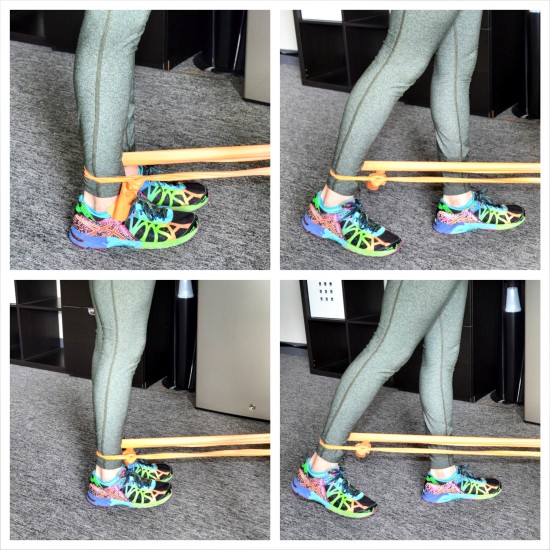
For this move, you will loop the band around a leg of your desk and tie it together so the band is tied in a big loop. Step one foot inside the band and place the band around your ankle.
Place your hands on a wall, chair or your desk to help you balance as you perform the movement. Standing tall with your standing leg slightly bent (the leg not in the band), kick the leg in the band straight back.
Do not rock or lean forward as you kick back just to get your leg back higher. Squeeze your glute and extend your hip to kick your leg back.
Hold at the top for a second and lower the leg back down. Repeat, kicking the same leg back again.
If you are doing this move correctly, you should feel your glute really working to power the move. You may also feel your hamstring assisting just a little, but you shouldn’t feel your low back engaging at all.
Keep your core tight as you kick back and don’t worry about the range of motion.
Complete all reps on one side before switching.
Standing Lateral Raise:
Often when we sit all day at a desk, our glutes become inactive and weak. And one glute muscle that can become weak and lead to hip and knee pain is the glute medius.
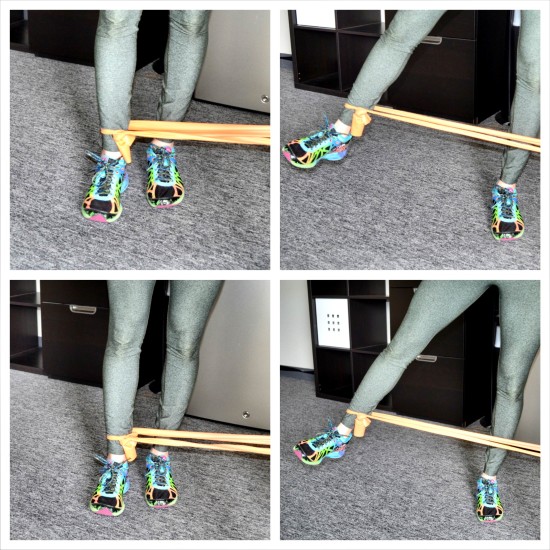
To strengthen the glute medius, hip abduction moves work really well. And one great move to work your glute medius as well as the muscles along the outside of your hip is the Standing Lateral Raise.
To do the Standing Lateral Raise, loop the band around a leg of your desk and tie it together so the band is tied in a big loop. Step one foot inside the band and place the band around your ankle.
Turn so your side is toward the desk and place your foot furthest from the desk in the band. You may want to face your chair or the wall so that you can place your hands on it for balance.
Then, keeping your leg fairly straight, lift your leg up and out to the side. Do not lean away just to get your leg up higher.
You may feel this a lot in your standing leg as well. Lift and hold for a second then lower the leg back down and repeat.
Keep your feet parallel. If you start to turn the toe of the lifted leg up toward the ceiling as you lift, you are working on external rotation instead of abduction.
Both moves are great to strengthen your glutes and the outside of your leg so you can use both. Just note that by rotating your toe open, you are working slightly different muscles and hitting the leg from a different angle.
Make sure you really feel the back outside of your hip working to lift.
Complete 10-15 reps on one side before switching.
Band Hip Hinge or Band Pull Through:
Another great way to work on hip extension and getting your glutes activated to prevent and alleviate knee, hip and low back pain is with the Band Hinge or Band Pull Through.
Both moves are standing hip hinge movements you can do with the band. The one difference is how the band is held during the movements. With the Band Hip Hinge, you will tie the band in a loop and place it around your hips. With the Band Pull Through, you will loop the band around your desk and then hold the ends of the band in between your legs as you perform the movement.
Both moves are basically the same movement, but you can hold in either way. The more tension you place on the band, so the further from the anchor point you walk, the harder both moves will be.
The Pull Through is show in the top two photos while the Band Hip Hinge is demonstrated in the bottom two.
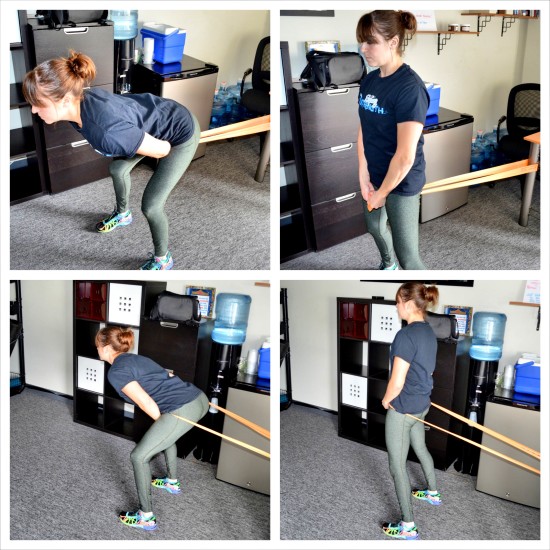
To do the Band Hip Hinge, loop the band around a leg of your desk and tie it together so the band is tied in a big loop. Step inside the loop and place the band up around your hips while facing away from the anchor point.
Walk away from the desk and anchor point to get an appropriate amount of tension on the band. Your feet should be about hip-width to shoulder width apart.
Then, with a slight bend to your knees, sit your butt back toward the desk as you hinge over. Your back should be flat as you hinge over. You may even feel a slight stretch in your hamstrings as you push your butt back.
Come back up to standing, squeezing your glutes to drive your hips forward. Keep your abs engaged as you stand up.
Stand up nice and tall then hinge back over, sitting your butt back.
Make sure to hold for a second or two at the top and feel your glutes engage. Really concentrate on feeling them work and not your low back.
Remember, you can also do the Band Pull Through and hold the band between your legs as you hinge over and stand back up.
Complete 15-20 reps.
Monster Walks:
To get you taking a few extra steps every day while activating your glutes and abduction muscles to help prevent knee, hip and low back pain, you need to include Monster Walks in your Desk Workout routine.
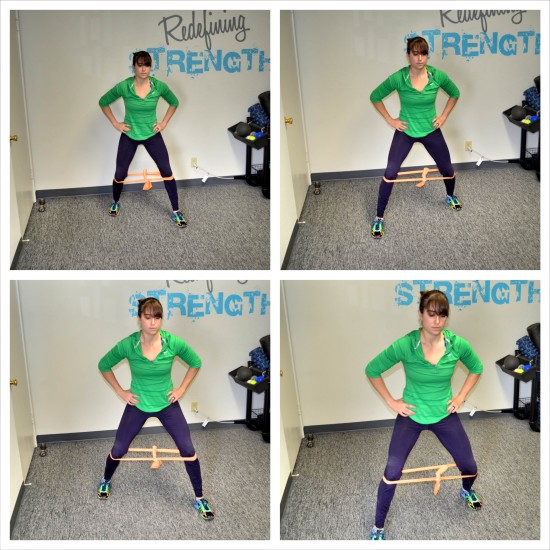
To do Monster Walks, tie the band in a loop and place it around your ankles. The smaller the loop, the harder the move will be. To make the move easier, place the band higher up your legs toward your knees. When you loop, if your band is long, you may have to double wrap it before knotting it like in the photos.
Then step your feet out to about shoulder-width apart. Start to walk forward taking big steps out and forward as you go. Try not to wiggle your hips a ton as you walk forward. Take big steps and don’t just swing your legs.
Once you’ve walked forward then start to take big steps out and back to walk backward. Try not to rotate your hips way open as you walk backward.
You want to take big steps and keep the band tight. You can do the Monster Walks with straighter legs or more of a squat.
Take at least 20 steps forward and 20 steps backward.
Band Side Shuffle:
The Band Side Shuffle is another great way to get moving more while working your glute medius and abductor muscles.
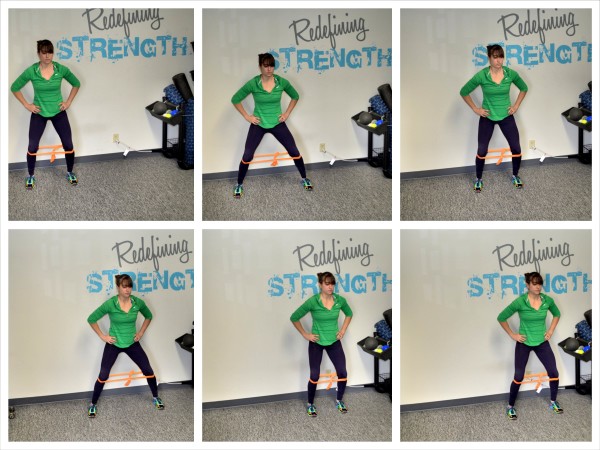
To do the Band Side Shuffle, you can either tie the band in a loop and place it around your legs or, if your band is larger, you can also simple step on the band with your feet about hip-width apart and an end of the band in each hand. Or you can double wrap it like with the Monster Band Walks
If you loop the band, the higher up toward your knees you place the band, the easier the move will be. And if your knees tend to cave in when you run or squat, you may want to start with the band up higher to correct your knee valgus.
With the band around your legs or your feet on the band and the band tight, begin to side shuffle. Never step your feet all the way together. Keep tension on the band at all times.
Take one step to the side then step the other foot in. Then step again to the side, bringing the other foot back in.
Take 20 steps to one side then side shuffle back.
You can do the Side Shuffle with straight legs or more of a squat. Make sure you don’t rock a ton from side to side as you shuffle.
Also, keep your feet parallel as you go.
Full Body/Core
Below are some great moves to strengthen your core to help prevent back and hip pain. These moves are also more full-body so they work a number of muscle groups at once to help you get more bang for your buck.
If you are short on time and want to strengthen your entire body and burn more fat, you need to include these full-body moves in your Desk Workout.
Squat to Press:
A great way to strengthen your legs, core and shoulders in one move is the Squat to Press. This is also a great move to get your blood pumping.
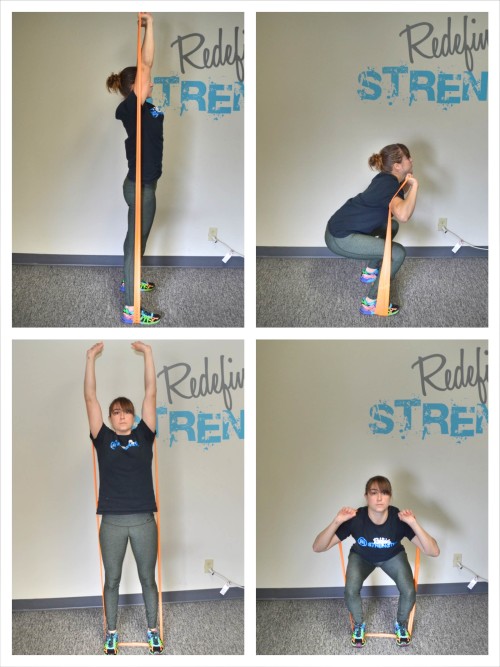
To do the Squat to Press, step on the resistance band and place your feet about hip-width to shoulder-width apart. The wider your stance, the harder the move will be because it will shorten the resistance band and add more tension.
Hold an end of the band in each hand and bring your hands up to your shoulders.
Then squat down, sitting your butt back. Go as low as you can while keeping your chest up. Do not let your heels come up as you squat down.
Once you’ve squatted as low as you can, drive back up to standing through your heels.
At the top, stand nice and tall and squeeze your butt. Brace your core as you press the band up overhead. Make sure your core is engaged so you don’t feel this in your low back.
After pressing overhead and fully extending your arms, bring your hands back down to your shoulders and squat again.
To make this move easier on your shoulders, you can use the momentum from your squat to help you press up overhead. To make the move harder, you can make it a stricter press and stand up before pressing.
Beginners may even find they can only stand with one foot on the band as they squat and press. This will also lessen the resistance.
Complete 10-20 reps.
Rotational Chop (low to high):
In every day life, we move in every plane of motion. Therefore, if we want to prevent pain and injury, we need to make sure to strengthen our body in every plane of motion.
The Rotational Chop will do just that. It is a great rotational move to work your entire core (aka everything from your shoulders to your knees).

To do the Rotational Chop, place a band around a low anchor point. For less resistance, tie the band around the desk so you are holding only one end in your hands. For more resistance, loop the band around and hold both ends in your hands.
Walk away from the anchor point so that there is tension in the band. Stand with your feet about shoulder-width apart and your side to the anchor point.
Then pivot your feet and bend your knees to reach the handle down outside the knee closest to the anchor point (make sure there is still tension in the band). Your arms should be straight and your chest should be up as you lunge down. Do not round your back to reach lower. Bend your knees and bring the hands outside your knee.
Then bring your arms up and across your body as you stand up and pivot toward the opposite side. You should end up reaching out at about shoulder height with your arms straight. Do not reach too high up as you reach across.
Then control the band back down and across as you pivot and bend your knees. Move in a slow and controlled fashion back down into a lunge with your hands outside your knee. Do not let the band pull you. Complete all reps on one side before switching.
Complete 10-15 reps per side. Walk further from the desk to increase the resistance or hold both ends of the band in your hands as you rotate from low to high.
Band Seesaw:
This is a great move to strengthen your glutes and back as well as your core and shoulders. For less resistance, tie the band around the desk so you are holding only one end in your hands. For more resistance, loop the band around and hold both ends in your hands.

To do the Band Seesaw, hold the band in both hands with your palms facing the ground. Step away so there is tension in the band. The further back from the desk you go, the harder the move will be.
Stand facing the desk and hinge over, pushing your butt back and leaning forward as you pull the band back between your legs. Your knees should bend slightly as you pull the band back between your legs, but make sure you are not squatting down.
Your arms should stay straight as you pull and your back should be flat. Feel a nice stretch down your hamstrings as you sit your butt back.
Then come back up to standing and pull the band back overhead. Keep your arms straight as you pull the band back overhead. Do not arch your low back, but stand up nice and tall to pull the band overhead.
Then hinge back over, pulling the band back between your legs. Make sure you do not feel this move in your low back.
Your glutes, hamstrings, core and shoulders should all be working.
Complete 10-15 reps.
Stability Press:
While rotational moves like the Rotational Chop are important to include in your workout routine, so are anti-rotational moves to help you build your core stability.
The Stability Press will work your abs and glutes especially your obliques and glute medius to help you build core stability and prevent injury.

To do the Stability Press, anchor the band around your desk as close to chest height as you can. For less resistance, tie the band around the desk so you are holding only one end in your hands. For more resistance, loop the band around and hold both ends in your hands.
Then hold the band in both hands and step away from the anchor point so that there is tension in the band. Face toward the band so that your body is sideways to the anchor point. Stand with your feet no more than shoulder-width apart. The closer your feet are together, the harder the move will be because you won’t have as wide a base to support you.
You will also want enough tension in the band that you feel your body wanting to rotate back toward the anchor point, but not so much tension that you can’t stabilize and press straight out.
Bring your hands to the center of your chest and slowly push the band straight out from the center of your chest until your arms are straight out. Do not let your arms rotate open and go back toward the anchor point.
Make sure to press straight out while not shrugging your shoulders. Maintain a nice tall posture with your shoulder blades drawn down and back and your chest pressed out.
Then slowly bring your arms back in and repeat. Move slowly to really have to fight the band. If you move too quickly, you won’t get as much out of the move. Complete all 10-15 reps on one side before turning and facing the other way to work the other side.
This move looks easy, but when you try it, you realize how much your entire body has to fight rotating back toward the anchor point. Step further away from the anchor point to make the move harder.
Band Twists:
Another great rotational move to work your core is Band Twists. Band Twists will work everything from your shoulders to your knees.
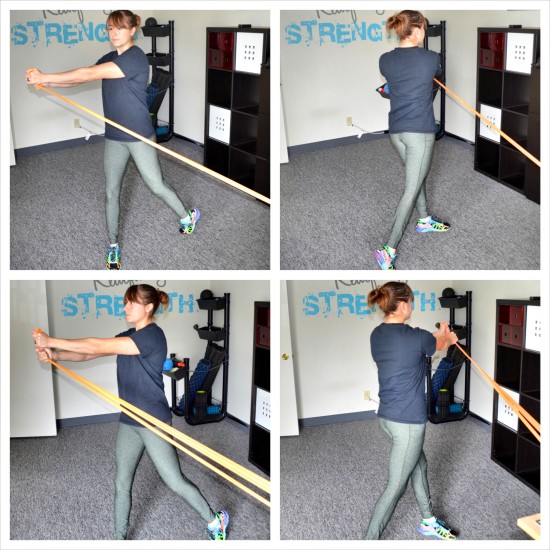
To do Band Twists, place a band around one of your desk legs. For less resistance, tie the band around the desk so you are holding only one end in your hands. For more resistance, loop the band around and hold both ends in your hands (shown in the bottom two photos).
Move back from the anchor point so there is tension in the band. Facing your desk, pull the band up so that your arms are out straight in front of you at shoulder height.
Then pivot to the right, twisting your arms and the band to the right. In a controlled manner, pivot to the left, pulling the band to the left.
Make sure that as you pivot, you turn your back foot so your hip, knee and foot stay in line and you aren’t twisting your knee in an odd direction.
Keep pivoting from side to side. Speed up the movement as you feel comfortable with form, but do not let the band pull you.
Also, make sure that you don’t shrug your shoulders and you maintain a nice tall posture as you twist.
If you feel this too much in your neck and traps or the resistance is too much, you can also do the Band Twist with your arms low.
Instead of having your arms out straight at shoulder height, as you pivot and twist, you can bring your hands and the band outside your hips. You will twist and bring the band from hip to hip.
Still maintain a nice tall posture and keep your abs braced so you don’t feel either variation in your low back.
Sink into a deeper lunge/squat with these to work your legs more.
Complete 10-15 reps per side alternating sides.
Bonus Move
Lunge with Lat Pull Down:
The more big muscle groups you can work at once, the more calories you will burn in less time. And with the Lunge with Lat Pull Down, you will work your legs and your back at the same time.
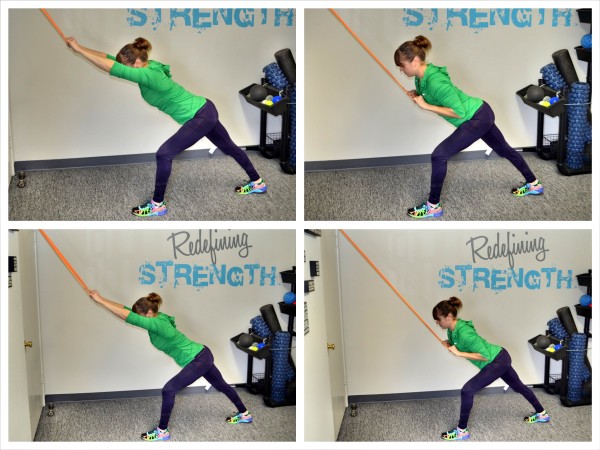
To do the Lunge with Lat Pull Down, you will need to anchor the band up high. A doorway can work if you have something to wrap the band in to hold it in the door.
Once you have the band set up, grab an end of the band in each hand. Walk back away from the anchor point and set up in a lunge stance.
Lunge back while facing the anchor point and lean your chest over your front knee. Your back leg can be straight, but you want to make sure to lean forward so that you work your lats and are performing a movement that mimics a vertical pull.
Reach your hands up overhead. There should be tension in the band with your arms extended. If there isn’t, move back. Then pull the band down toward your shoulders, driving your elbows down and back. The movement should mimic you pulling yourself up to a bar for a pull up.
As you pull down, pinch your shoulder blades down and together. Focus on working your back muscles. You want to feel the sides of your back pulling the band down. Don’t just go through the motions. You want to consciously activate the big muscles of your back.
The slowly extend your arms back out and repeat. Each time you pull down, drive your elbows down and back. Hold for a second or two.
Keep your core engaged the entire time and your back flat. Do not start to straighten up and turn this into a row instead of a pulldown.
You may also feel this move in your legs because you are holding a low lunge.
Change the tempo or move back further from the anchor point to make the move more challenging.
Complete 10-15 reps of the Lunge with Lat Pull Down. Make sure you move slowly and feel the sides of your back working to pull the band.
Using the Moves
With these 15 moves, and one bonus move, you can get in a great workout at your desk. Pick even just one or two movements to do a round of when you get up from your desk. One time you could do Pull Downs and Monster Walks.
The next time you could do Scapular Band Flyes and Band Hip Hinges. Just simply moving more and doing the opposite of what you do seated all day at a computer is going to help you prevent pain and injury and improve your health.
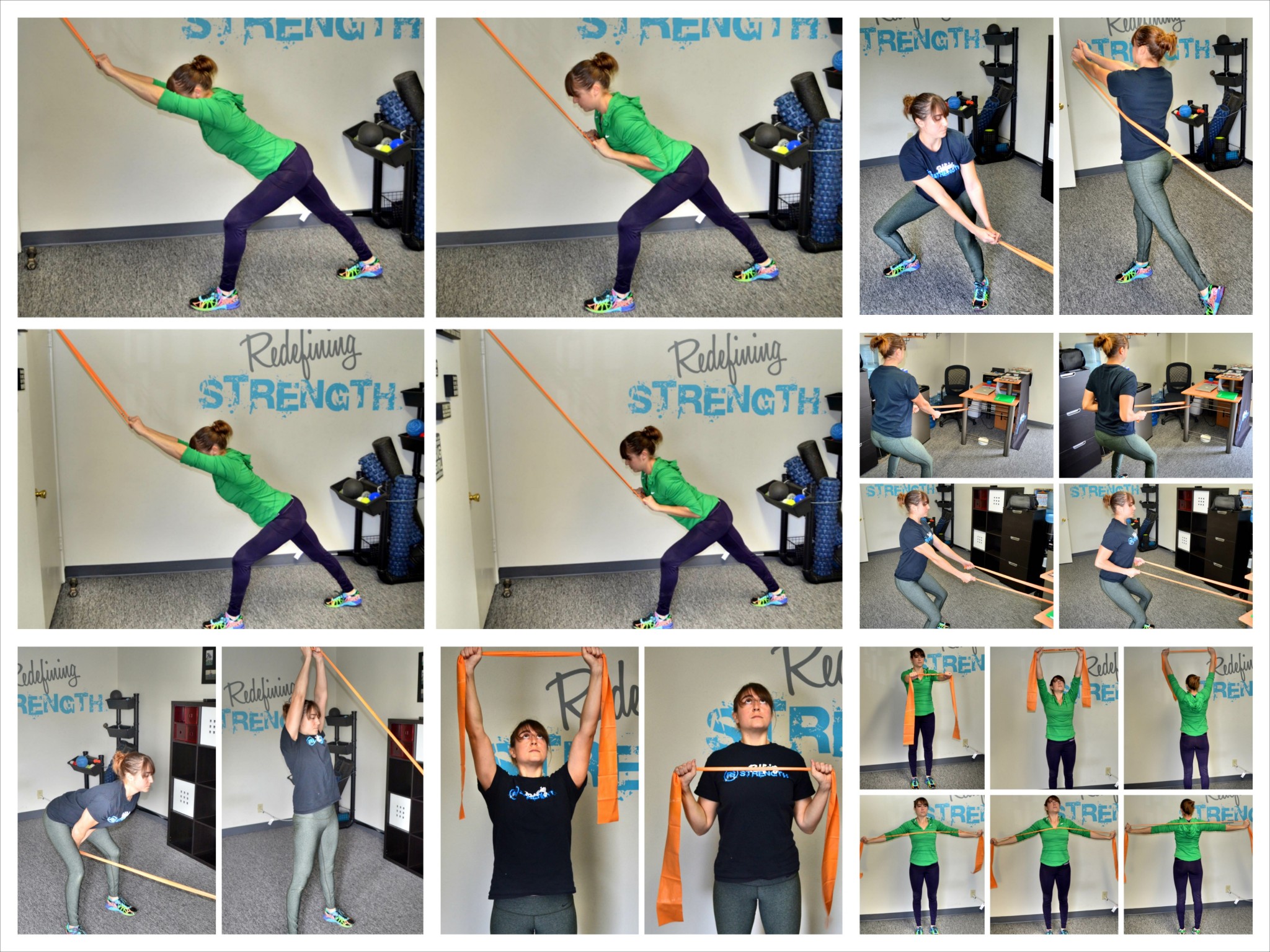
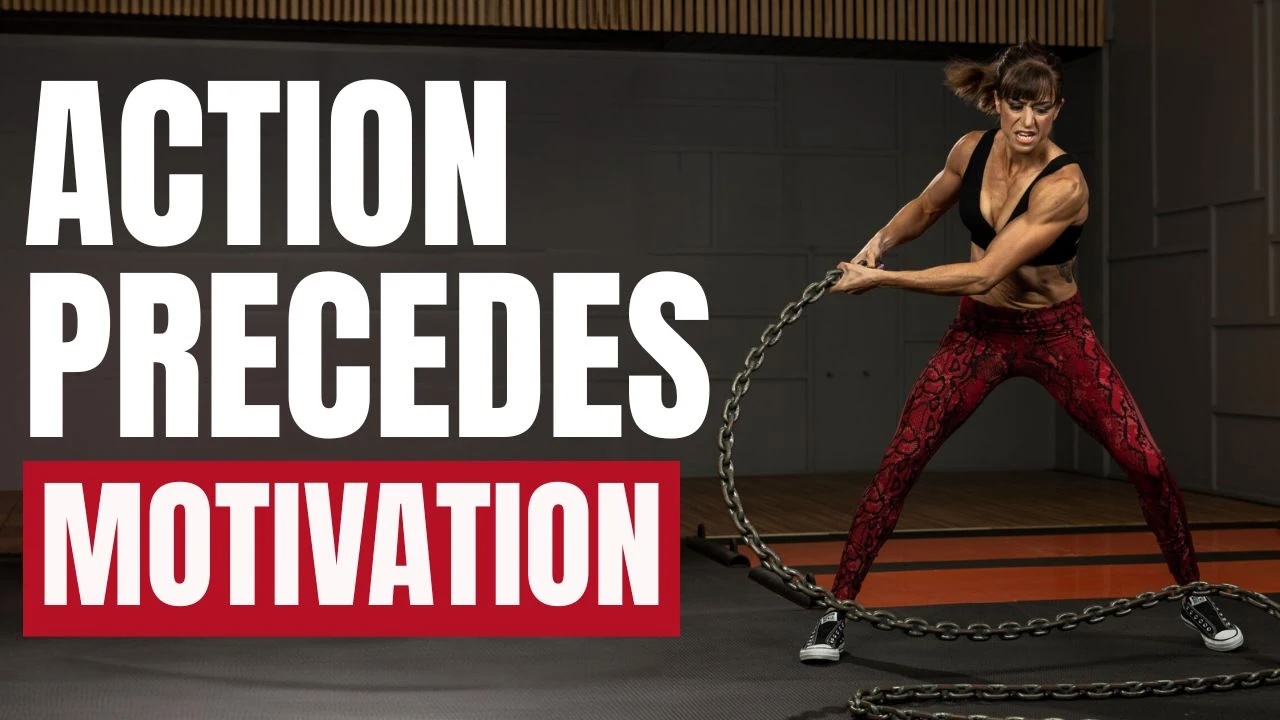
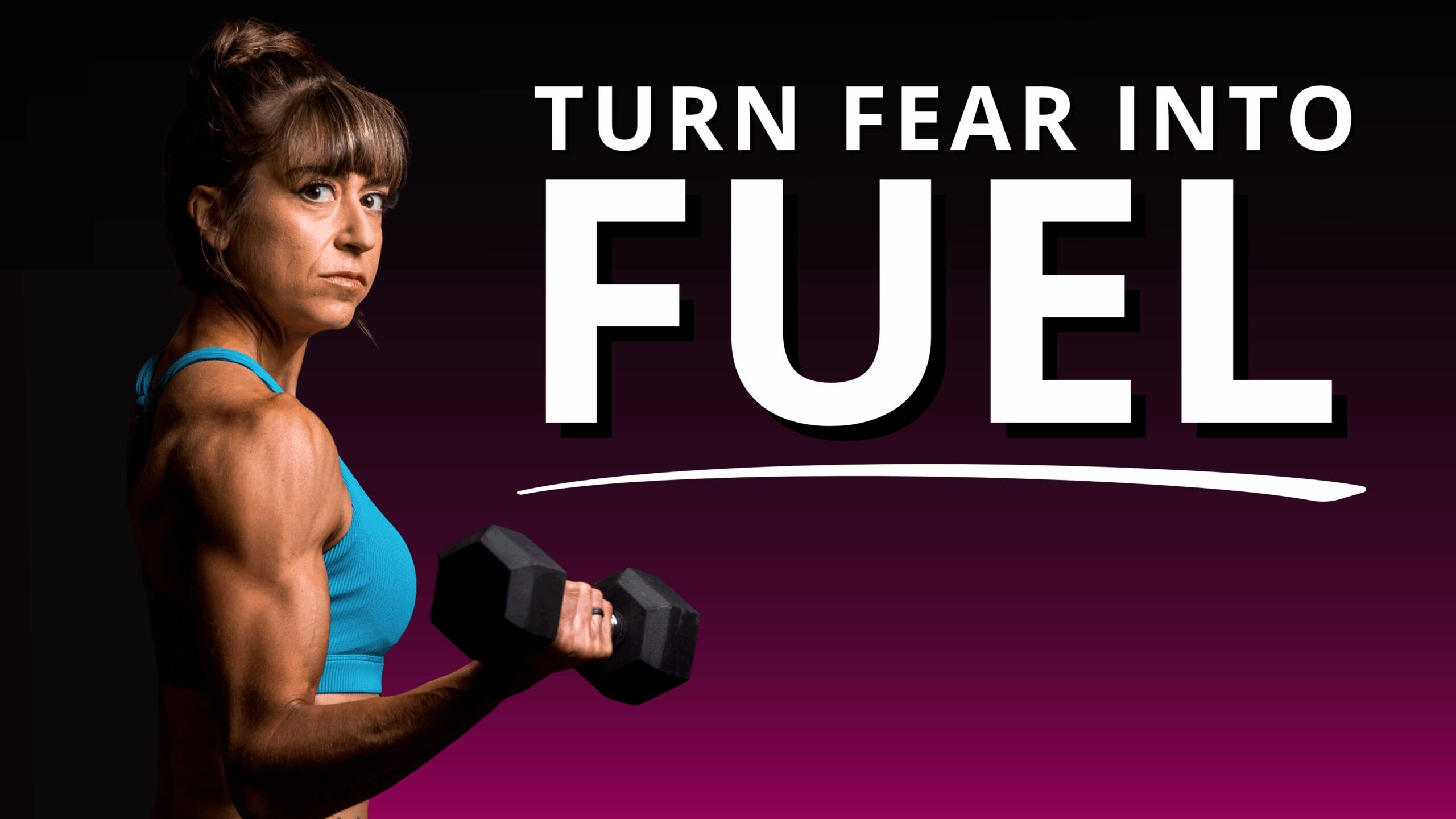
Is there a brand of the bands you can recommend? I’m finding mostly loops, but I don’t think they’d be long enough…
Thanks!
Hi Laura
I’ll send you an email as well, but I used a theraband – http://www.performbetter.com/webapp/wcs/stores/servlet/Product2_10151_10751_1003956_-1_1000354_1000352_1000281?img=412&kbid=6773
Thanks!
Cori